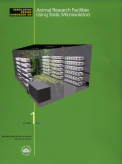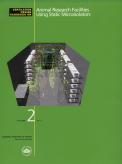 |
Principal Investigator: Farhad Memarzadeh
Division of Technical Resources
Office of Research Services
National Institutes of Health
Bethesda, Maryland
September 1998 |
 |
Why You Should Read and Refer to this Document
A number of recent facilities have been built with high level exhaust systems. This happened as a result of publications that reported on studies that concentrated on the thermal ventilation efficiency of the macroenvironment. Those studies ignored the internal cage microenvironment. When the exhaust is placed at high level, it is easy to overlook the reduced cage ventilation efficiency for filter top cages. Designers, facility managers, and veterinarians should therefore refer to this document when they need to make an informed decision on the choice of exhaust location.
This document also provides valuable information about ventilation rate per 100g of stock and its relationship with bedding change frequency. Furthermore the research indicates our ability to reduce ammonia generation by raising temperatures. This may have energy efficiency benefits for rooms operating largely or exclusively on cooling, although consideration must be given to the relative humidity in those situations.